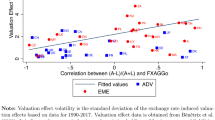Abstract
We examine cases in which there is a large shift in a country’s net foreign asset position due to the re-valuation of its foreign assets and/or foreign liabilities. We highlight the differences in large valuation shocks between countries characterized by large gross stocks of foreign assets and foreign liabilities and countries exhibiting large net external positions. Finally, we analyze macroeconomic dynamics in the neighborhood of large valuation episodes.





Similar content being viewed by others
Notes
Although we take Eq. 1 as the valuation channel, it is important to mention that part of the difference between the change in the net foreign asset position and the capital flows may be explained by data revisions (Lane and Milesi-Ferretti 2009). This decomposition of net foreign assets dynamics between the valuation term and current account is also analogous to Eq. 21 in Ghironi et al. (2007).
We compare diversification finance versus development finance international investments. See Obstfeld and Taylor (2003).
We analyze only advanced countries with negative Type-A large valuation episodes because we are interested in drawing general cross-country regularities and the only advanced country with a positive Type-A episode is the United Kingdom in 1999.
In this group, South Africa is the only country experiencing real appreciation (2.9%). If we exclude this country to compute the mean depreciation, the mean fall would have been −20.7%.
References
Calvo, G., Izquierdo, A., & Meijía, L.-F. (2004). On the empirics of the sudden stops: The relevance of balance-sheet effects. In: Proceedings. Federal Reserve Bank of San Francisco.
De Gregorio, J. (2005). Global imbalances and exchange rate adjustment. (Economic Policy Papers Central Bank of Chile 15). Santiago de Chile: Banco Central de Chile.
Edwards, S. (2004). Financial openness, sudden stops and current account reversals. American Economic Review, 94(2), 59–64.
Eichengreen, B., Rose, A., & Wyplosz, C. (1995). Exchange market mayhem: The antecedents and aftermath of speculative attacks. Economic Policy, 10(21), 249–312.
Ghironi, F., Lee, J., & Rebucci, A. (2007). The valuation channel of external adjustment. (NBER Working Papers 12937). Cambridge, MA: National Bureau of Economic Research.
Gourinchas, P.-O., & Rey, H. (2007a). From World Banker to World Venture Capitalist: U.S. External Adjustment and the Exorbitant Privilege. In: R. Clarida (Ed.), G7 current account imbalances: Sustainability and adjustment. Chicago: University of Chicago Press.
Gourinchas, P.-O., & Rey, H. (2007b). International financial adjustment. Journal of Political Economy, 115(4), 665–703.
Hung, J., & Mascaro, A. (2004). Return on cross-border investment: Why does the U.S. investment abroad do better? (Working Paper 2004-17). Washington D.C.: Congressional Budget Office.
IMF (2005). World Economic Outlook. Globalization and external imbalances (Chapter III, pp. 109–156). Washington, DC: IMF.
Lane, P. R., & Milesi-Ferretti, G. M. (2001). The external wealth of nations: Measures of foreign assets and liabilities for industrial and developing countries. Journal of International Economics, 55(2), 263–294.
Lane, P. R., & Milesi-Ferretti, G. M. (2006). Exchange rates and external adjustment: Does financial globalization matter? (The Institute for International Integration Studies Discussion Paper Series 129). Dublin: IIIS.
Lane, P. R., & Milesi-Ferretti, G. M. (2007a). The external wealth of nations mark II: Revised and extended estimates of foreign assets and liabilities, 1970–2004. Journal of International Economics, 73(2), 223–250.
Lane, P. R., & Milesi-Ferretti, G. M. (2007b). A global perspective on external positions. In: R. Clarida (Ed.), G7 current account imbalances: Sustainability and adjustment. Chicago: University of Chicago Press.
Lane, P. R., & Milesi-Ferretti, G. M. (2009). Where did all the borrowing go? A forensic analysis of the U.S. external position. Journal of the Japanese and International Economies, 23(2), 177–199.
Milesi-Ferretti, G. M., & Razin, A. (1998). Sharp reductions in current account deficits an empirical analysis. European Economic Review, 42(3–5), 897–908.
Milesi-Ferretti, G. M., & Razin, A. (2000). Current account reversals and currency crises: Empirical regularities. In: P. Krugman (Ed.), Currency crises. (NBER Conference Report series). Chicago and London: University of Chicago Press.
Obstfeld, M., & Rogoff, K. (2007). The unsustainable U.S. current account position revised. In: R. Clarida (Ed.), G7 current account imbalances: Sustainability and adjustment. Chicago: University of Chicago Press.
Obstfeld, M., & Taylor, A. (2003). Globalization and capital markets. In: M. D. Bordo, A. M. Taylor, & J. G. Williamson (Eds.), Globalization in historical perspective. (NBER Conference Report series). Chicago and London: University of Chicago Press.
Tille, C. (2008). Financial integration and the wealth effect of exchange rate fluctuations. Journal of International Economics, 75(2), 283–294.
Acknowledgments
The author would like to thank an anonymous referee for helpful comments and suggestions, Philip R. Lane for his continuous encouragement and help with the External Wealth of Nations database. The author gratefully acknowledges the Institute for International Integration Studies (IIIS) at Trinity College Dublin for financial support.
Author information
Authors and Affiliations
Corresponding author
Appendix: countries and data sources
Appendix: countries and data sources
Countries: The set of countries used to identify the 59 large valuation shocks is formed by 17 emerging markets and developing countries and 21 advanced countries. The former is composed of Argentina, Brazil, Chile, China, Colombia, India, Indonesia, Israel, Korea, Malaysia, Mexico, Pakistan, the Philippines, South Africa, Thailand, Turkey and Venezuela. The latter group is formed by Australia, Austria, Canada, Denmark, Finland, France, Germany, Greece, Iceland, Ireland, Italy, Japan, the Netherlands, New Zealand, Norway, Portugal, Spain, Sweden, Switzerland, the United Kingdom and the United States.
Data: Stocks and flows of foreign assets and liabilities (Lane and Milesi-Ferretti 2007a). Trade balance (Direction of Trade Statistics, IMF). Constant GDP in local currency (World Development Indicators). Current account balance and real exchange rate (International Financial Statistics, IMF). Equity price index (Morgan Stanley Capital International Inc.). Total return bond index (Global Financial Data). Foreign assets are the sum of portfolio equity assets, foreign direct investment and debt assets (debt assets includes foreign exchange reserves minus gold). Foreign liabilities are the sum of portfolio equity liabilities, foreign direct investment and debt liabilities.
About this article
Cite this article
Bénétrix, A.S. The anatomy of large valuation episodes. Rev World Econ 145, 489–511 (2009). https://doi.org/10.1007/s10290-009-0026-1
Published:
Issue Date:
DOI: https://doi.org/10.1007/s10290-009-0026-1




